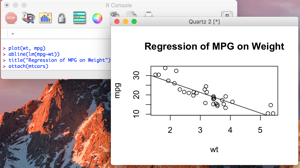R Tutorial
Obtaining R
R is available for Linux, MacOS, and Windows. Software can be downloaded from The Comprehensive R Archive Network (CRAN).
Startup
After R is downloaded and installed, simply find and launch R from your Applications folder.
![]()
Entering Commands
R is a command line driven program. The user enters commands at the prompt ( > by default) and each command is executed one at a time.

The Workspace
The workspace is your current R working environment and includes any user-defined objects (vectors, matrices, data frames, lists, functions). At the end of an R session, the user can save an image of the current workspace that is automatically reloaded the next time R is started.
Graphic User Interfaces
Aside from the built in R console, RStudio is the most popular R code editor, and it interfaces with R for Windows, MacOS, and Linux platforms.
Operators in R
R's binary and logical operators will look very familiar to programmers. Note that binary operators work on vectors and matrices as well as scalars.
Arithmetic Operators include:
| Operator | Description |
| + | addition |
| - | subtraction |
| * | multiplication |
| / | division |
| ^ or ** | exponentiation |
Logical Operators include:
| Operator | Description |
| > | greater than |
| >= | greater than or equal to |
| == | exactly equal to |
| != | not equal to |
Data Types
R has a wide variety of data types including scalars, vectors (numerical, character, logical), matrices, data frames, and lists.
Creating New Variables
Use the assignment operator <- to create new variables.
# An example of computing the mean with variables
mydata$sum <- mydata$x1 + mydata$x2
mydata$mean <- (mydata$x1 + mydata$x2)/2
Functions
Almost everything in R is done through functions. A function is a piece of code written to carry out a specified task; it may accept arguments or parameters (or not) and it may return one or more values (or not!). In R, a function is defined with the construct:
function ( arglist ) {body}
The code in between the curly braces is the body of the function. Note that by using built-in functions, the only thing you need to worry about is how to effectively communicate the correct input arguments (arglist) and manage the return value/s (if any).
Importing Data
Importing data into R is fairly simple. R offers options to import many file types, from CSVs to databases.
For example, this is how to import a CSV into R.
# first row contains variable names, comma is separator
# assign the variable id to row names
# note the / instead of \ on mswindows systems
mydata <- read.table("c:/mydata.csv", header=TRUE,
sep=",", row.names="id")
Descriptive Statistics
R provides a wide range of functions for obtaining summary statistics. One way to get descriptive statistics is to use the sapply( ) function with a specified summary statistic.
Below is how to get the mean with the sapply( ) function:
# get means for variables in data frame mydata
# excluding missing values
sapply(mydata, mean, na.rm=TRUE)
Possible functions used in sapply include mean, sd, var, min, max, median, range , and quantile.
Plotting in R
In R, graphs are typically created interactively. Here is an example:
# Creating a Graph
attach(mtcars)
plot(wt, mpg)
abline(lm(mpg~wt))
title("Regression of MPG on Weight")
The plot( ) function opens a graph window and plots weight vs. miles per gallon. The next line of code adds a regression line to this graph. The final line adds a title.

Packages
Packages are collections of R functions, data, and compiled code in a well-defined format. The directory where packages are stored is called the library. R comes with a standard set of packages. Others are available for download and installation. Once installed, they have to be loaded into the session to be used.
.libPaths() # get library location
library() # see all packages installed
search() # see packages currently loaded
Getting Help
Once R is installed, there is a comprehensive built-in help system. At the program's command prompt you can use any of the following:
help.start() # general help
help(foo) # help about function foo
?foo # same thing
apropos("foo") # list all functions containing string foo
example(foo) # show an example of function foo
Going Further
If you prefer an online interactive environment to learn R, this free R tutorial by DataCamp is a great way to get started.